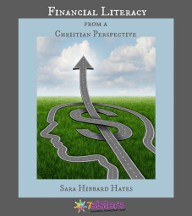Financial Literacy from a Christian Perspective is a biblically-based course in personal finances for home educated students about ages 14 through 20. While the core text is only 138 pages, it incorporates numerous weblinks within every lesson to articles, videos, and activities pertinent to each topic. So it ends up providing a great deal of lesson material between the text and online resources.
It addresses fundamentals in regard to attitudes and beliefs that relate to finances as it covers topics such as what we consider to be most important in our lives, God’s view of wealth, the difference between needs and wants, and a Christian work ethic.
Simultaneously, it is a very practical course covering topics such as financial goal setting, budgeting, saving, investing, maintaining a checkbook, credit, credit reports and scores, financial institutions and their services, insurance, preventing identity theft, career choices, the costs and benefits of getting a college education, and taxes. Some of these areas are rarely covered in other economics textbooks for teens. The lesson on taxes is a good example. This course has students not just learn about the existence of taxes, but it teaches them how to complete the forms and file federal income taxes. Many adults could learn from the wealth of information in this course on taxes and other topics!
The combination of text and weblinks has it strong and weak points. The weblinks allow the author to include a wealth of multi-sensory material, contrasting views, and activities that would not otherwise be possible. Yet, this approach also means that there is some redundancy as weblinks sometimes repeat material previously presented in the text or other resources. Also, some weblinks will no longer be functional and students will need to search for the recommended material at another URL or skip it.
The course comes as a set of four PDF files. Along with the text file are three files with worksheets, tests, and answer keys respectively.
The 62-page worksheets file serves as a workbook where students will answer questions, complete charts, and create both hypothetical and personal financial plans and records. The worksheet activities expand on particular topics within a lesson. For example, they learn the real cost of credit using an online calculator and a worksheet. Similarly they use an online auto loan amortization worksheet and a mortgage amortization worksheet along with online calculators for auto loans and for mortgages to compare interest rates, length of the loans, total interest costs, and other important factors to consider when obtaining financing. A few of the worksheets address biblical principles taught in the lesson material. The lessons within the text include periodic questions as well as instructions as to when students are to complete each worksheet. Students can type onto the worksheets on the computer then print out their completed pages, a feature many students will appreciate.
While the course is very practical, it does take some strong biblical positions. For example, on page 73 it says, “Debt is bondage. Don’t allow yourself to get into unnecessary debt in the first place! Use self-control in your spending habits; don’t be greedy or envious of others; be content with what the Lord has given you.” This is followed by four Bible verses. In line with the biblical principle, the course includes among “Suggestions for Further Reading” in Appendix A titles such as Debt-Free by 30 and Rich Dad, Poor Dad—secular resources that reinforce the biblical admonition to live debt free. This and other biblical admonitions advanced by the course are ones that, for the most part, reflect common sense and are broadly acceptable.
The text has Study Sheets after every one or two chapters, and the test file has tests corresponding to the Study Sheets. Study Sheets fully prepare students for each test with review questions and activities.
While students can work independently, a few questions direct students to talk with their parents about something such as their views on tithing or strategies they use to manage household spending (Chapter 3). Note that parents might be reluctant to share some financial information such as their own credit score with their children. So parents should probably at least glance through the material to know what their students will be asking, and consider how they might respond. Parents will also need to correct answers from both lessons and tests. Since some answers are not predictable, parents will need to be familiar enough with the material to evaluate student responses.
Summary
Financial Literacy from a Christian Perspective does a more thorough job teaching what teens need to learn about finances than do most standard Economics courses. Student still need to study economics in the broader sense (the economy, prices, supply and demand, the market, etc.), but this course can certainly replace the coverage of personal finances in most texts. I suspect that students in their junior or senior years of high school as well as college students are likely to benefit most from this course since these are the ages where they usually have to start confronting financial realities.









